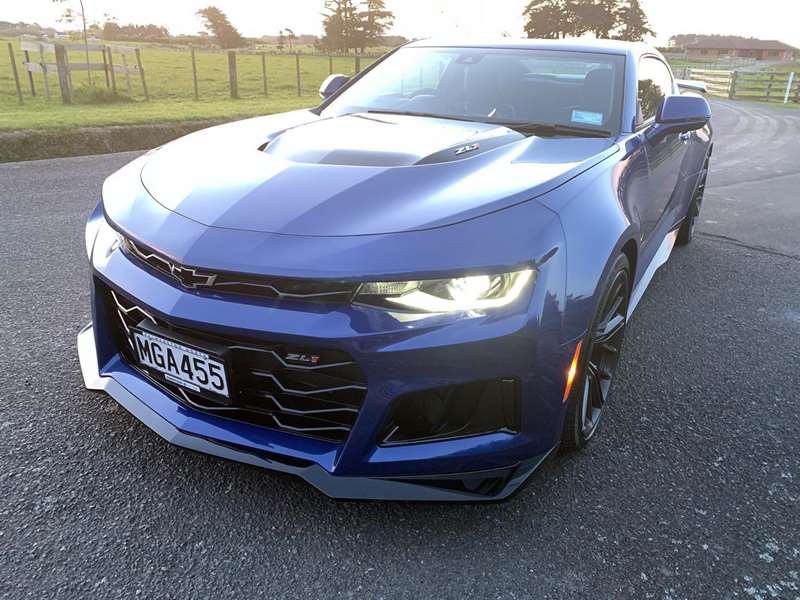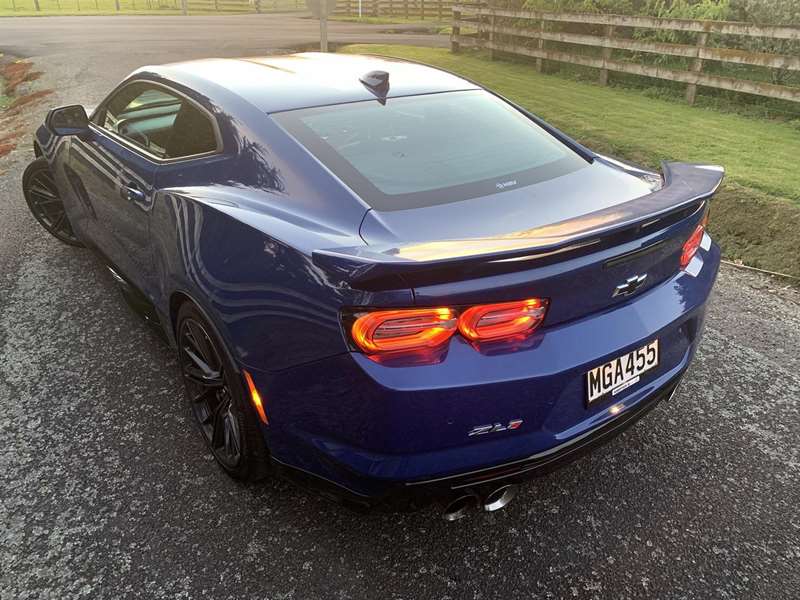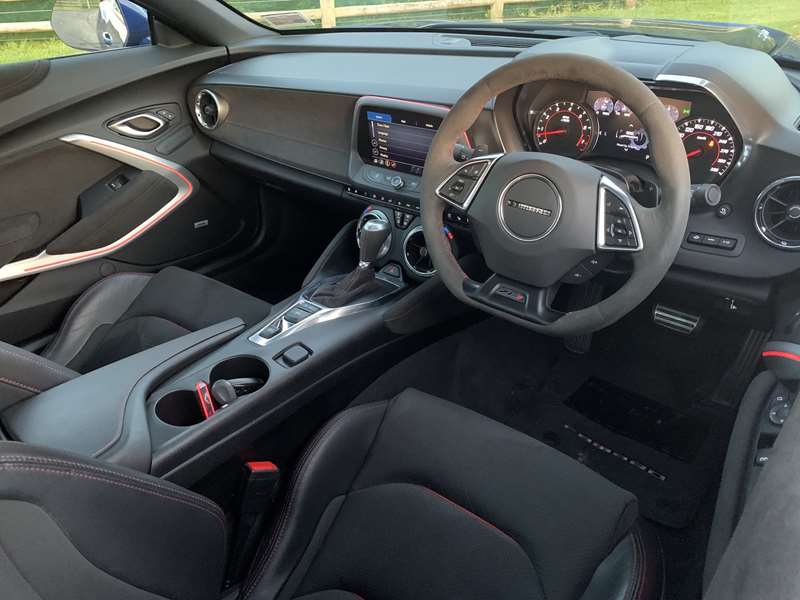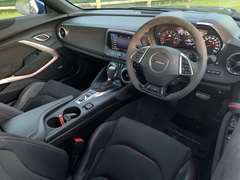Richard Bosselman gets behind the wheel of the HSV Camaro ZL1 and holds on for his life.
What’s new?
It’s not so much the car — it’s the sixth-generation Camaro, in production since 2015 and then given a facelift last year — as the job Holden Special Vehicles has done on it.
Plenty of after-market outfits have been converting Camaro to right-hand drive, but the Clayton, Victoria, crowd is the first to do so with GM recognition.
The commission has been going since 2018 and the ZL1 is the second version HSV has tackled on a line initially set up for the slightly less headstrong 2SS edition.
HSV had converted more than 1000 of those — starting with a six-speed auto model then transferring to that mid-life update car with an improved 10-speed automatic (six-speed manual) — before it turned its attention to this $175,990 edition.
One common belief about Camaro is that it comes in two flavours: big power (2SS) V8 and even bigger power (ZL1) V8.
‘‘Bigger’’ means a 40% increase in power alone. This engine essentially creates the same outputs generated by a V8 Supercar so it is well fit for tyremarmalading, horizon-gulping malevolence.
That HSV has maintained traditional shyness about releasing full performance data doesn’t matter, because Chevrolet can fill in all the gaps in respect to ballistics.It cites the US version as being good for 0-100kmh in 3.5 seconds, an 11.4 second quarter-mile at 204kmh and a top speed of just under 320kmh.
The king of Camaro’s bite goes beyond the ferocity of this engine. Cost shock when comparing the HSV with ex-US imported Camaros is significant.
Getting the fully built cars from the United States to Australia then ripping them apart, reconfiguring them and then sending them across the Tasman . . . it’s a big-bucks exercise that pumps the showroom price well above the price you will pay to secure, and import, a US domestic-format equivalent.
Of course, this way you buy a new car, with a warranty and the satisfaction of a job well done.
But calling it a conversion is an insult. There’s a lot more to the process than anyone may realise. Each car is stripped to its bare body before being meticulously rebuilt, a process that takes about 100 hours and provisions a complete re-engineering of the front end, demanding 500 bespoke parts, half going forward of the B-pillar and the rest within the cabin. The biggest single ‘‘new’’ bit is a locally produced dashboard. HSV also reshapes the footwell by cutting and welding replacement pieces and the engine bay is also reconfigured to enable a mirror image outcome. A new clutch arm and front sway bar were needed after the originals simply didn’t fit after the conversion.
What comes as standard?
Equipment runs to a 7.0-inch infotainment screen with Apple CarPlay and Android Auto, parking sensors at either end, blind-spot warning system, leather finishes, dual-zone ventilation, heated seats, ventilated seats, wireless phone charging and a nine-speaker Bose sound system. There’s also a head-up display.
However, its kit isn’t as comprehensive as HSV’s homegrown cars — this is more of a working-class car than those Commodore-based products were. And don’t expect any of those fancy driver assists that come with a Mercedes for the same money. Satellite navigation is also absent, but GM’s software allows you to use a smartphone app.
The main use of that monitor is to access many of the performance features: you can find various launch control settings and even adjust the engine revs at which the car will take off. There’s also a burnout mode feature Ford has removed from Mustangs sold here.
The steering wheel is rich with buttons for pretty much everything from the sound system to various driver-selectable functions to alter the car’s character. There are also paddle shifters to allow manual gear shifts in the automatic.
What’s it like to look at?
Aesthetics are subjective and I’m no Camaro expert, but this car certainly stands out in a New Zealand streetscape as a particularly menacing-looking exemplar of the whole muscle car ethos.
It’s certainly a slave to historic fashion. Camaro lore has it that the designers were rebuffed from raising the roofline and increasing the glass area, which would have resolved the visibility issues, because this would have impaired the silhouette.
ZL1-specific cues include a unique blackened grille that has divided fans and bumper with a lower edge that protrudes further forward, a sizeable rear wing and darkened bonnet bulge that is also vented. HSV blacks out the Chevrolet badges but restricts its own branding to a sticker in the rear window.
What’s it like inside?
Something of a museum piece: the design is dated and the quality of the plastics are a reminder of its roots as a blue-collar car with a burger-diet equipment level. And it’s dark in there.
You fall into the driver’s eight-way electrically adjustable seat and find it’s surprisingly firm, form-fitting and very comfortable.
The one must-do before taking off is ensuring the mirrors are adjusted to give the best possible view of what’s behind and beside you. Even then, there are a lot of blind spots. Visibility is poor and that includes the view forward — stop at an intersection and you’ll be craning to see around the A-pillar and the front-seat passenger to check the road is clear. And it’ll be just the two of you on board, as a colleague pointed out, because the second row of seats is nothing more than a bargaining tool for the ‘‘crisis car’’ conversation this kind of coupe inspires.
The cabin is clearly where HSV hit a brick wall. Your left elbow rests in a cupholder while your passenger gets the benefit of the arm-rest that had to remain in its original position. The media screen points weirdly downward and away from the driver, the PNDR panel is on the wrong side of the gear stick and, amusingly, the indicator chime resonates from the left-hand side. But at least the bonnet release is on the driver’s side.
Storage space inside is patchy and, for a car so immense, it has a teensy boot — just 260 litres — though at least the rear seat backs can fold flat for larger items.
What’s it like to drive?
If your dream is to be in a massive, hugely muscled and utterly bombastic example of American excess that draws attention as easily as a magnet pulls iron filings . . . then this is your car.
If your nightmare is to be in a huge, petrol-guzzling, somewhat overdone lane-filler that other drivers will either run away from or laugh at . . . well, ditto.
Overall, while less finessed than a Mustang, it’s still a car that surprises with its driving appeal. Sure, some of the dynamics are rough-edged; yet overall the chassis and suspension tuning are well considered. It loves the highway and isn’t afraid of secondary roads, where it weaves through tight bends with an ease that belies everything you thought you knew about American cars. That it sits almost unnervingly flat through the bends, has little body roll and has a crisp, connected steering feel just blows away any preconceptions.
The power you’re playing with has to be respected — you need to keep your wits about you on loose or wet surfaces. And don’t even think about taking it out of the garage in snow or ice.
In optimal condition and kept out of the full performance settings, the traction control is nicely calibrated, torque faithfully limited and it’s all fairly relaxed, the only indication there’s plenty happening in the background is the orange light flickering in the instrument cluster. Switch to Performance Track mode and, well, let’s just say it demands constant vigilance.
The front line of defence is provisioned by powerful six-piston Brembo brakes clamping pizza tray-sized discs that do a good job of slowing 1.8 tonnes of muscle car. The HSV differs from US-market ZL1 in tyre choice. The factory-fit footwear that fell foul of Australian wet-weather emergency braking regulations is softer and stickier than the replacement Continentals, yet the latter are probably better every day, as they have a more road-biased profile.
Handling and ride benefit from a newer version of the magnetic ride control (MRC) found in HSV’s homegrown Commodore-based product.
The engine is . . . well, something else. You soon discover why it has 11 radiators to cool its various systems. It dishes up phenomenal performance, leaping hard off the line to the point where those tyres will overcome the traction control and break, at least momentarily, into wheelspin. Switch traction control off and you can leave nice black lines that remain untarnished all the way through first and second gears.
Throttle response is terrific, too, and there’s never a lack of pull anywhere in the rev range. And it revs cleanly right up to the 6400rpm power peak.
One area the engine takes a backward step compared with the less powerful one in the 2SS is sound. The woofy V8 bark when you first step on it, something typically accompanied by skips of wheelspin, is drowned out by the less appealing banshee whine of the supercharger.
Fuel use? Yup, it knows what to do with it. Regardless that there’s an active fuel management (AFM) that momentarily stops firing four of the eight cylinders, even when treading lightly it stands as one of the thirstiest cars on the road. It’s no friend of the planet either, with a CO2 output higher than 350g per 100km.
Verdict
Even in today’s world, the Camaro feels like a throwback to a fast-fading past and with allegiance in its home country now seriously wavering, its relevance in tomorrow’s world must be all the more questionable.
Where pure enjoyment and a throbbing V8 soundtrack is concerned, the Camaro pushes all the right buttons, yet with a healthy premium above what you’ll probably pay for the same car imported as-new from the United States, the HSV product demands an especially fierce loyalty.












